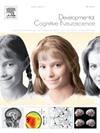基于脑电图的婴幼儿脑年龄预测:对早期发现神经发育障碍的意义。
IF 4.6
2区 医学
Q1 NEUROSCIENCES
引用次数: 0
摘要
婴儿的大脑在生命的头三年经历了快速的发育变化。通过使用神经影像学预测实足年龄来了解这些变化,可以为典型和非典型大脑发育提供见解。我们利用457名2至38个月大的正常发育婴儿的938个静息状态脑电图记录来建立年龄预测模型。多层感知器模型的准确率最高,R2为0.83,平均绝对误差为91.7天。特征重要性分析结合了层次聚类和Shapley值,确定了描述周期性α和低β活动的两个特征聚类作为年龄的关键预测因子。将该模型应用于后来被诊断为自闭症或唐氏综合症的婴儿的脑电图数据显示,实足年龄被严重低估,这支持了该模型作为早期识别大脑发育改变的临床工具的潜力。本文章由计算机程序翻译,如有差异,请以英文原文为准。
EEG-based brain age prediction in infants–toddlers: Implications for early detection of neurodevelopmental disorders
The infant brain undergoes rapid developmental changes in the first three years of life. Understanding these changes through the prediction of chronological age using neuroimaging can provide insights into typical and atypical brain development. We utilized 938 resting-state EEG recordings from 457 typically developing infants, 2 to 38 months old, to develop age prediction models. The multilayer perceptron model demonstrated the highest accuracy with an R of 0.83 and a mean absolute error of 91.7 days. Feature importance analysis that combined hierarchical clustering and Shapley values identified two feature clusters describing periodic alpha and low beta activity as key predictors of age. Application of the model to EEG data from infants later diagnosed with autism or Down syndrome revealed significant underestimations of chronological age, supporting its potential as a clinical tool for early identification of alterations in brain development.
求助全文
通过发布文献求助,成功后即可免费获取论文全文。
去求助
来源期刊

Developmental Cognitive Neuroscience
NEUROSCIENCES-
CiteScore
7.60
自引率
10.60%
发文量
124
审稿时长
6-12 weeks
期刊介绍:
The journal publishes theoretical and research papers on cognitive brain development, from infancy through childhood and adolescence and into adulthood. It covers neurocognitive development and neurocognitive processing in both typical and atypical development, including social and affective aspects. Appropriate methodologies for the journal include, but are not limited to, functional neuroimaging (fMRI and MEG), electrophysiology (EEG and ERP), NIRS and transcranial magnetic stimulation, as well as other basic neuroscience approaches using cellular and animal models that directly address cognitive brain development, patient studies, case studies, post-mortem studies and pharmacological studies.
 求助内容:
求助内容: 应助结果提醒方式:
应助结果提醒方式:


